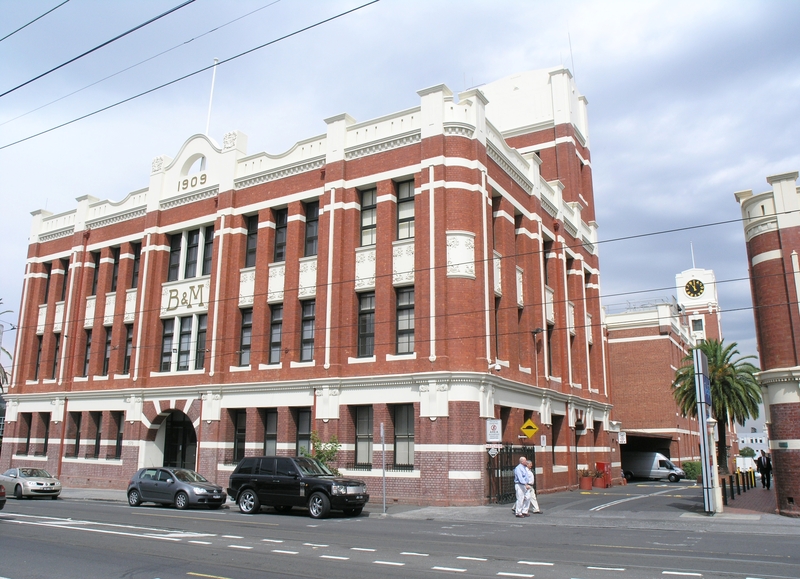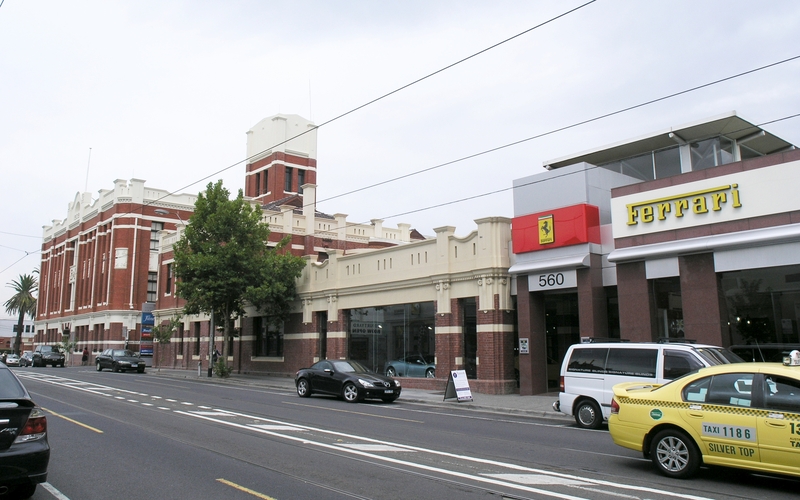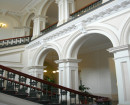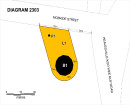FORMER BRYANT & MAY INDUSTRIAL COMPLEX
560 CHURCH STREET CREMORNE, YARRA CITY
-
Add to tour
You must log in to do that.
-
Share
-
Shortlist place
You must log in to do that.
- Download report





Statement of Significance
What is significant?
The former Bryant and May Industrial Complex in Richmond is a superb, largely intact Edwardian factory complex. The existing complex was built in 1909 to a design by William Pitt. The builder was Clements Langford. A further section was added behind it in 1910 and in 1917 a dining hall was constructed. The machinery for the factory was made in the USA, but none of it survives. A further building programme in 1921-22 included the western extension of the factory, a new chimney stack and boiler house, and offices and Brymay Hall, all designed by Klingender and Hamilton. The builder for the extension was T. Donald and Co. The 1909 offices were extended in 1934 by Arthur and Hugh Peck, architects. The 1920s saw the introduction of many staff amenities, including the tennis courts, basketball courts and a bowling green.
How is it significant?
The former Bryant and May Industrial Complex is of historical, architectural and social significance to the State of Victoria.
Why is it significant?
The former Bryant and May Industrial Complex is of historical significance as evidence of the development of industry in Melbourne from the early 20th century. The history of the Bryant and May complex reveals a great deal about the history of manufacturing in Victoria. The English firm Bryant and May began manufacturing matches in Australia in 1885. It occupied two sites in Richmond and amalgamated with another British match manufacturer operating in the suburb before the growing size of its operations and workforce necessitated the construction of the existing complex. With 280 employees, Bryant and May had become a major employer, and in 1909, as a result of the merger and to accommodate new processes and increased production, a new factory was built adjacent to its old factory, a former brewery. These initial years show the importance of British capital in the development of Victoria's industry. The various changes in the buildings over the years can be directly related to the introduction of protective tariffs, their removal and the dumping of matches from overseas, and technological innovations. Machinery was regularly updated to cope with new processes and the declining use of wax matches. The consumption of matches generally had declined and together with strong overseas competition forced the firm to diversify and merge yet again. By the late-1980s, the company had vacated the factory, reinforcing the pattern of de-industrialisation of Melbourne's inner suburbs.
The former Bryant and May Industrial Complex is of historical significance as a rare surviving example of model factory conditions and amenities. The complex was run as a model factory and reflected the Quaker principles of the original English founders. Evidence of the amenities provided for its workers such as the tennis courts and dining room is still substantial. One of the first industrial nurses in Australia was employed at the factory from 1922.
The former Bryant and May Industrial Complex is of architectural significance for the quality and cohesion of its architectural development and for its association with the important Melbourne architect, William Pitt. The factory complex is one of the finest remnants of Richmond?s industrial heyday and its substantial intactness provides an excellent indication of industrial organisation and design of the early 20th century. Pitt designed the complex towards the end of an eminent career that was innovative, prolific and wide ranging. Other significant industrial buildings for which he was responsible were the Denton Hat Mills in Abbotsford and the Foy and Gibson complex in Collingwood.
The former Bryant and May Industrial Complex has social significance as an important long-term part of the Richmond and inner Melbourne landscape. The factory was initially important as a large employer in working class Richmond, but has over the years also become a prominent landmark for both local residents and other residents of Melbourne. Its clock tower has been a familiar sight to generations of train travellers and visitors to the Melbourne Cricket Ground, and the complex has featured in films and television programs set in Melbourne. Bryant and May's 'Redheads Matches', intimately associated with the factory, are still a well-known commercial icon in Victoria.
-
-
FORMER BRYANT & MAY INDUSTRIAL COMPLEX - History
Associated People:
FORMER BRYANT & MAY INDUSTRIAL COMPLEX - Permit Exemptions
General Exemptions:General exemptions apply to all places and objects included in the Victorian Heritage Register (VHR). General exemptions have been designed to allow everyday activities, maintenance and changes to your property, which don’t harm its cultural heritage significance, to proceed without the need to obtain approvals under the Heritage Act 2017.Places of worship: In some circumstances, you can alter a place of worship to accommodate religious practices without a permit, but you must notify the Executive Director of Heritage Victoria before you start the works or activities at least 20 business days before the works or activities are to commence.Subdivision/consolidation: Permit exemptions exist for some subdivisions and consolidations. If the subdivision or consolidation is in accordance with a planning permit granted under Part 4 of the Planning and Environment Act 1987 and the application for the planning permit was referred to the Executive Director of Heritage Victoria as a determining referral authority, a permit is not required.Specific exemptions may also apply to your registered place or object. If applicable, these are listed below. Specific exemptions are tailored to the conservation and management needs of an individual registered place or object and set out works and activities that are exempt from the requirements of a permit. Specific exemptions prevail if they conflict with general exemptions. Find out more about heritage permit exemptions here.
-
-
-
-
-
FORMER LALOR HOUSE
 Victorian Heritage Register H0211
Victorian Heritage Register H0211 -
ST STEPHENS ANGLICAN CHURCH
 Victorian Heritage Register H0586
Victorian Heritage Register H0586 -
PRIMARY SCHOOL NO. 2084
 Victorian Heritage Register H1634
Victorian Heritage Register H1634
-
"1890"
 Yarra City
Yarra City -
"AMF Officers" Shed
 Moorabool Shire
Moorabool Shire -
"AQUA PROFONDA" SIGN, FITZROY POOL
 Victorian Heritage Register H1687
Victorian Heritage Register H1687
-
'Aqua Profonda' sign wall sign, Fitzroy Swimming Pool
 Yarra City H1687
Yarra City H1687 -
'DRIFFVILLE'
 Boroondara City
Boroondara City -
1) WEATHERBOARD FARM HOUSE AND 2) THE OUTBUILDINGS
 Nillumbik Shire
Nillumbik Shire
-
-















